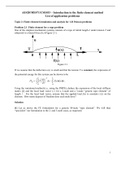Exam (elaborations)
AE420/ME471/CSE453 – Introduction to the finite element method List of application problems University of Illinois, Urbana Champaign AE 420
AE420/ME471/CSE453 – Introduction to the finite element method
List of application problems
Topic 2: Finite element formulation and analysis for 1-D Poisson problems
Problem 2.1 Finite element for a rope problem
One of the simplest mechanical systems consists of a rope of initial length L und...
[Show more]
Preview 3 out of 22 pages
-
February 8, 2023
-
22
-
2022/2023
-
Exam (elaborations)
-
Questions & answers
All documents for this subject (1)
AE420/ME471/CSE453 – Introduction to the finite element method
List of application problems
Topic 2: Finite element formulation and analysis for 1-D Poisson problems
Problem 2.1 Finite element for a rope problem
One of the simplest mechanical systems consists of a rope of initial length L under tension T and
subjected to a lateral force f(x) (Figure 2.1).
u
T u(x) T x
0 L
f(x)
Figure 2.1
If we assume that the deflection u(x) is small and that the tension T is constant, the expression of
the potential energy for this system can be shown to be
L L
1 du 2
Π p = ∫ T dx − ∫ f (x )u( x )dx .
2 dx
0 0
Using the variational method (i.e., using the PMPE), deduce the expression of the local stiffness
matrix [k] and the local load vector {r} for a 2-node and a 3-node “generic rope element” of
length l . For the local load vector, assume that the applied load f(x) is constant (=fo) on the
element. How many degrees of freedom does each node have?
Solution
(1) Let us derive the FE formulation for a generic M-node “rope element”. We will then
“specialize” our formulation to the 2- and 3-node cases, as requested.
1
, 1 du
l 2 l
Π = ∫ T ds −
e
∫ f (s) u(s)dx , (1)
2 0 ds 0
where
Πe = potential energy of the "generic element"
l = length of the element
f (s) = distributed transverse load acting on the element
Let u˜(s) = N(s) {d}, (2)
where
N(s) = N1 (s) N 2 (s) .. N M (s) = vector with M shape functions
d = U1 U 2 .. U M = vector with M modal displacements (1dof/node)
du˜
(2) ⇒ = N ' {d} = d {N '}
ds
Substitute into Πe in (1) :
l l
˜ e = 1 ∫ (T d {N } N ' {d})ds −
Π ∫ f (s) d {N }dx =
1
d [k ]{d}− d {r}
20 0
2
where
l
dN(s) dN(s)
[k ] = ∫ T ds
0
ds ds
(1,M)
(M,M)
(M,1 )
l
{r} = ∫ f (s) {N }ds
(M,1) 0 (M,1 )
(2) 2 - node " rope element" (M = 2)
s s 1 1
→ N = N1 N 2 = 1− ⇒ N = −
l l l l
l −1 l T 1 −1
[k ] = ∫ T 1 l −1 l 1 l ds =
l −1 1
0
s
l 1− 1 2
{r} = ∫ f0 l ds = f0 l
0 s 1 2
l
2
, (3) 3 - node rope element (M = 3)
2(s − l)(s − l / 2) −4s(s − l) 2s(s − l / 2)
→ N = N1 N 2 N 3 =
l2 l2 l2
4s − 3l 4(2s − l) 4s − l
⇒ N′ = −
l2 l2 l2
l
7/ 3 −8/ 3 1/ 3
T
[k ] = ∫ T {N '} N ' ds = −8/ 3 16/ 3 −8/ 3
l
0 1/ 3 −8/ 3 7/ 3
2 l
2 (s − 2 )(s − l)
l 4 1 6
l
{r} = ∫ f0 − 2 s(s − l) ds = f0 l 2 3
l 1 6
0
2 s(s − l )
l 2 2
U1 U2 U1 U2 U3
• o o o o
s=0 s=l s=0 s=l/2 s=l
2- Node Element 3-Node Element
3




